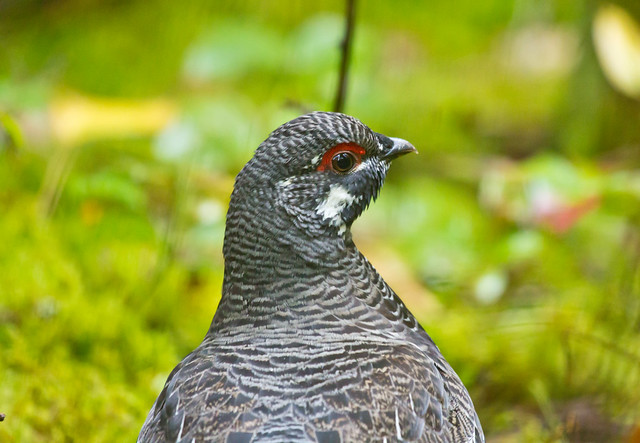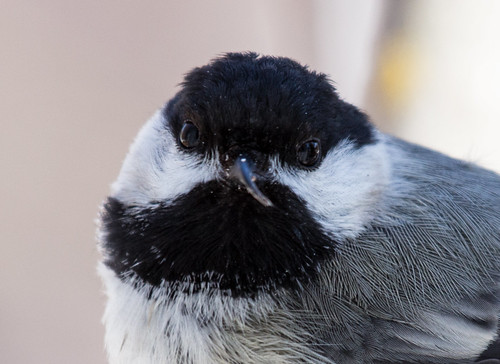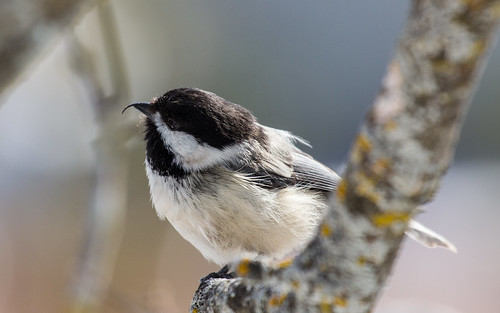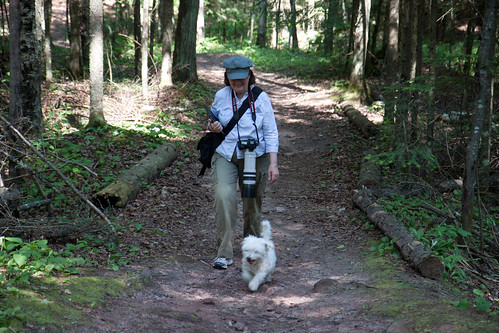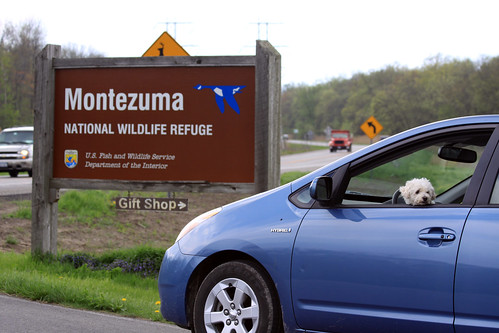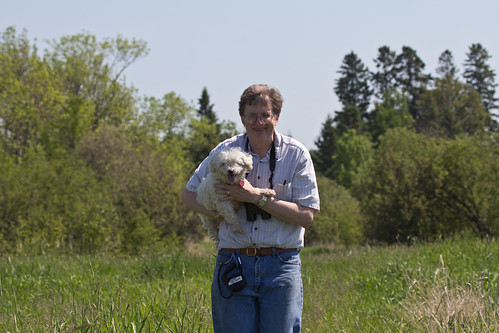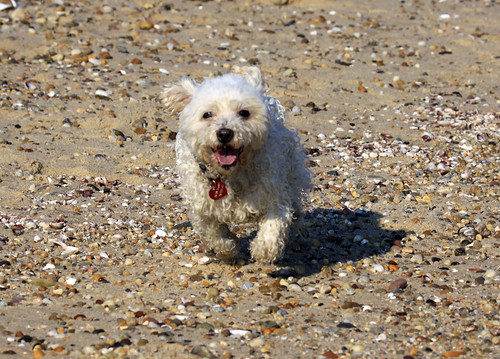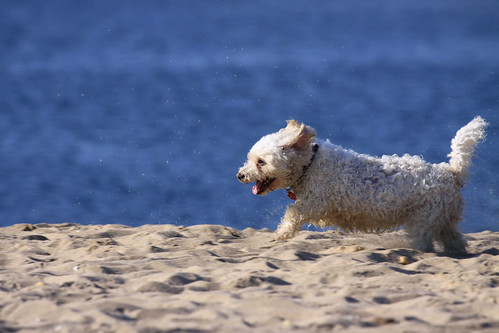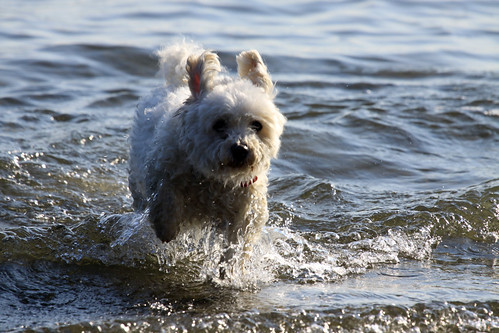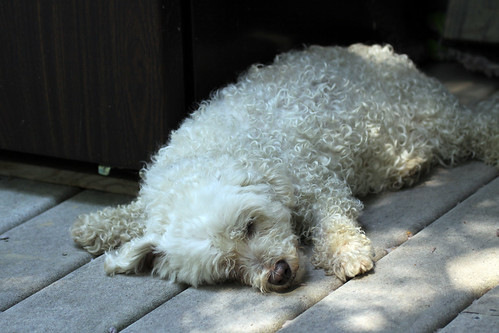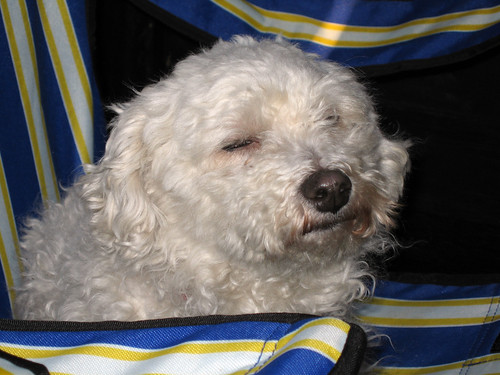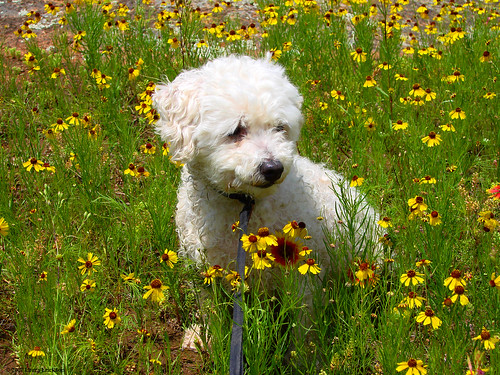On July 2, 1998, I drove down to southern Minnesota to pick
up a brand new puppy—a 12-week old bichon frise. She was a tiny particle of
light and energy, so I named her Photon.
I’m not an assertive kind of person, so I need a dog that is
even less assertive than I am. Our golden retriever Bunter—my constant
companion while my kids were growing up—and then Photon both fit the bill. They both
learned the basic commands—come, sit, stay, and down—almost instantly, as if
when I told them what to do, they thought, “What a great idea!” rather than
submitting to my will. Bunter, being a golden, had an over-developed sense of
guilt. I called her my Roman Catholic dog, because anytime anything went wrong
or any child cried, she hung her head and seemed to be examining her conscience
trying to figure out what mortal sin she’d committed that was making her family
suffer. Photon had all Bunter’s agreeableness and good cheer, but none of her guilt. When things went wrong, she just took a nap in a closet until the clouds
passed.
While I was housebreaking Photon, we spent a lot of time in
the backyard. It took her a while to figure out that there was a point to our
being out there, but while sniffing around, she discovered an anthill. Of
course she stuck her nose right in, and some of the ants got stuck in her
nostrils—some may have even bit her. This was an instant lesson in the
importance of keeping her little nose out of things even as it increased her
curiosity about the fascinating world at her feet. For the remainder of the summer, most of the times I took her out, she would stand, transfixed, watching that ant hill for 10 or 15 minute stretches. And for the next 16 years,
whenever she noticed an insect, frog, salamander, or other tiny critter on the
ground, she’d stop dead in her tracks like an exceptionally happy pointer, her
tail wagging furiously but otherwise not moving a muscle till I praised her for
finding me yet another interesting creature. Every salamander I’ve ever seen in
the wild was thanks to my tiny herpetologist. And her quarry was never the
worse for the encounters—she never ever touched them, maybe because of that uncomfortable
experience with ants up her nose.
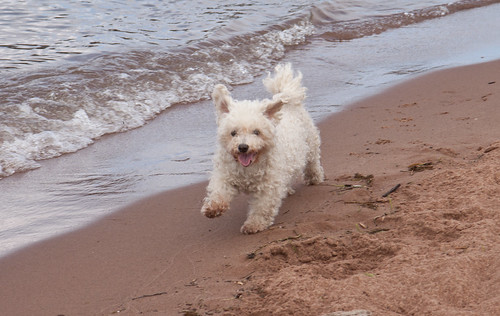
Bichon frises are one of the breeds people think of as foo
foo dogs, but Photon never got that memo. The first time I brought her to Lake
Superior, on a walk along Brighton Beach, she saw a golden retriever fetching
sticks and instantly figured out that the really cool dogs swim. It was a warm summer day,
but the next spring, she was out there swimming among ice floes. I kept her on
a long retractable leash when there were shorebirds about. I didn’t need to
worry about her scaring gulls—they watched her with disdain. A Bald Eagle
once circled around a few times looking down on her, but then flew off—Bichons
originated in Italy and take their name from French, and I figured our nation’s
symbol must prefer all-American food.
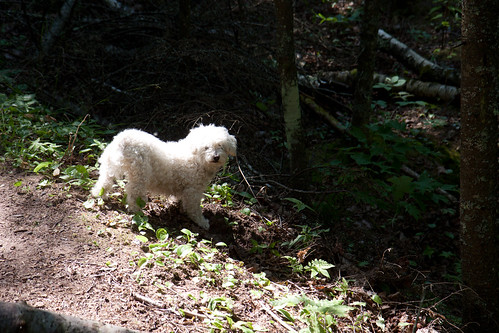
Not many people walk in the woods with little foo foo
dogs, so birds have no clue what they are. Species that had always ignored us or
disappeared when I walked with my golden retriever Bunter would come down low
to scold Photon. I had some of my closest looks ever at Magnolia,
Black-throated Green, and Chestnut-sided Warblers when I walked with her. One Winter Wren almost alighted on my hand he was so intent on
giving her a piece of his mind. After I figured that out, I stopped walking her
on narrow paths during the nesting season—the birds didn’t seem so agitated
when we stuck to the middle of gravel roads.
A week or two after I got her, Photon and I went on one of
my friend Kathleen Anderson’s women in the outdoors events. We started the day
with a 6-mile hike. Jamie Nelson was along with a couple of her sled dogs.
Photon was thrilled to be so close to these splendid big dogs, and kept trying
to get them to play with her, but she was as invisible to them as the tiny subatomic
particle she was named for. Large fallen trees blocked the trail here and
there. The two big dogs sailed over them effortlessly. Photon scooted under
them or scrambled to climb over. She ran ahead of us and then back again
the whole distance while the sled dogs conserved their energy. The hot summer day was too warm for them, but
Photon never did seem to notice that she was outshining them.
At the end of the day, Kathleen had arranged for a dinnertime
cruise on the Grandpa Woo. I could hardly leave such a young puppy in the car
for three hours, so I took her onboard with me. After we were out on the water,
the server said they didn’t allow dogs on the boat, but it was too late to turn
back. Photon was perfectly well behaved, even waiting till I had her positioned
just right in the women’s bathroom to practice her housebreaking skills.
I've never known a dog to be as aware of microclimates as Photon. In the car, the house, or wherever we happened to be, she could always find the coolest or warmest spot. On hot days at Hawk Ridge, she'd find a shady spot by a car. I couldn't leave her in the car when it was hot, obviously, but as long as I left a thick blanket in the car, she was fine in winter--if she got cold, she simply burrowed under the blanket. When I had an evening event in the Twin Cities, she’d come along for the ride, even
though all she got to do was ride in the car for three hours, wait in the car
for an hour and a half or so, and then ride home again for another three hours. She saw my car as our special place, and never minded being left there. As I walked away, she always curled up on the drivers seat, keeping it warm for me or, if it was warm outside, on the floor in the shade. She’d wake up and start wagging the moment I opened the door on returning.
On our drives, I made it a point to stop at every rest stop so she
could at least enjoy those little walks. When we had time, we’d stop at
wildlife refuges and parks we chanced by, but she was always agreeable even when we had to drive long stretches between stops.
The moment I put my binoculars around my neck at home, she’d start dancing, knowing we were going on an adventure. Her favorite birding destination was Port Wing, Wisconsin, where she knew all the good spots because we spent so much time there.
All in all, she visited at least 31 different states and
Washington D.C. Wherever she went, Photon felt at home in the world. I called her my chickadee dog for her size, her sense of belonging and confidence no matter what the habitat, and her funny manner of eating--she'd take a kibble or bite of food from the dish to eat in a different spot, and then return to the dish to take the next bite. And like a chickadee, she was calm and easygoing, welcome just about everywhere she went.
I had to keep her close in the
Wichita Mountains Wildlife Refuge in Oklahoma, where some of the white-tailed deer in the campground attack little dogs—one had recently kicked a puppy so hard it ruptured its spleen—and diamondback rattlesnakes can be anywhere. The
only time she came upon a rattlesnake, it was a little one. Photon froze,
staring intently and wagging as she always did when she found something cool. I
praised her as I scooped her up out of harm’s way.
One night during a storm, two rangers woke us up
to evacuate us—tornadoes had been touching down nearby. They took us to the
refuge education center in a big old log cabin. In the middle of the main room
was a mounted mountain lion rearing up on its hind legs—the moment Photon saw
it, she shrank, but I carried her over to it and showed her it wasn’t
dangerous. She always trusted me, even when it came to oversized predators.
Photon came along when my sister-in-law Jean and I visited
relatives on Long Island in 2009. When we brought her to a beach, Photon
charged right in as if it were Lake Superior, and took a big drink. The look of
shock on her face when she tasted saltwater was hilarious, but I could hardly wound her pride by laughing. The buoyancy of the salt water held her
so much higher than Lake Superior that I thought she was walking in shallow
water until I stepped in--there was a huge drop off right near shore.
She swam and ran and had a jolly time for several hours. As soon as we got back to the house, she fell fast asleep.
Photon was a late sleeper, but she came with me to western
Minnesota when I had reservations in a prairie chicken blind.
I told her if she came along she’d
have to sit still in a folding chair for at least 4 hours, but that was
fine with her. We arrived in the blind at 4 am, while she was still very sleepy, and
she didn’t make a peep the whole time the prairie chickens were dancing,
even though she’d never heard such fascinating sounds before. The chickens
were right outside the blind, occasionally even landing on the roof. The people
in the blind next to ours arrived late, left early, and were noisy—they hadn’t turned off
the electronic noises on their camera and left their cell phone on, flushing the birds
several times. But my birding companion understood the rules.
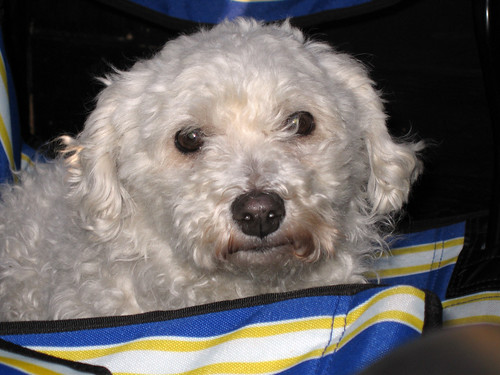
When we'd set out on an adventure, I'd always tell her we were going to have "such larks, Pip!" On a single road trip, she and I went to Theodore Roosevelt National Park, Yellowstone
National Park, the Bear River National Wildlife Refuge and Arches National Park in Utah, Bosque del
Apache National Wildlife Refuge in New Mexico, and various other stops along the way. I never kept a life list for her, but I’m sure I’ve seen
at least 450 species with Photon at my side. I brought her along to Arkansas
when I spent a month there with my friend Paula Lozano during the big search for
an Ivory-billed Woodpecker. Originally I was planning to leave her home because the trip was going to be so long, but the day before I left, when I closed my suitcase, it was way heavier than it should have been. I opened it to find her burrowed into my clothes. How could I not take her along?
Sometimes she'd sit in my lap as I drove, her head resting in the crook of my arm. I'd sing, "I wanna good luck charm a hangin' on my arm" as she settled in for a long stretch. Usually we were by ourselves, but Paula got a photo on our trip.
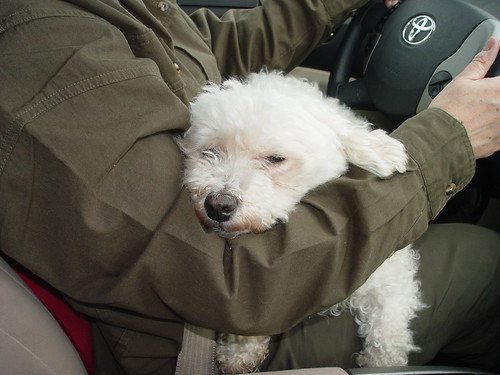
One night on our Arkansas trip as we were settling into our sleeping
bags in the tent, we heard distant coyotes. Photon whined a little, and
suddenly, there they were—at least 6 or 8 coyotes circling, noses poking
against the tent here and there, breathing and snuffing in all our scents. Photon
was thrilled, yearning as always to play with the big guys. I’m afraid the
coyotes’ thoughts were more centered on the culinary opportunities. I finally thought
to press the emergency button on my car keys. The moment the lights started flashing
and the alarm started up, the coyotes disappeared into the night.
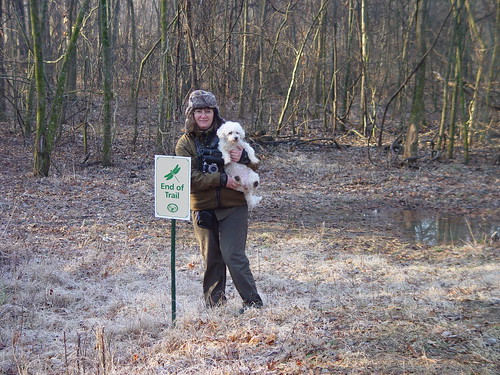
On that trip, we visited several national wildlife refuges,
and Photon got to show off at every refuge office. She had three adorable
tricks. When I’d say, “Roadkill!” she’d flatten herself, back legs splayed
backward, head flat down on the floor between her front legs, her tail wagging merrily
away. I’d touch her tail saying, “Not happy roadkill! Tragic roadkill,” and her
tail would sink slowly to the floor. Once she finished that one, I’d say “Oh,
no! Mommy’s got a gun!” and point my finger at her. The moment I said, “Bang,”
she’d keel over on her side, tail wagging away. Then, when we were about to
leave, I’d tell her to wave bye bye, and she’d raise one paw in the most
endearing little wave.
A lot of people mistook Photon for a male. Maybe it was her
tricks. Maybe it was her spunk and stamina—she had no trouble on long hikes
till she was over 12 years old. Maybe it was the association people made with
Star Trek’s photon torpedoes. But she was very much my little girl, whether she
was being my sidekick on adventures or my companion at home. Virtually every
time I drove between Duluth and Ithaca when I was working at the Cornell Lab,
she was there at my side. We had plenty of non-birding adventures, too—I occasionally took her to work with me, and I smuggled
her into my son Joey’s dorm room at the University of Wisconsin-Milwaukee, and
into Katie’s dorm room at Oberlin College. She was in love with my sister
Mary’s greyhound Buster, and adored Mary, too. We stopped by her house
a lot while I was commuting back and forth to Ithaca, while Mary was in the
final stages of breast cancer. Photon was always well mannered but was especially gentle with Mary.
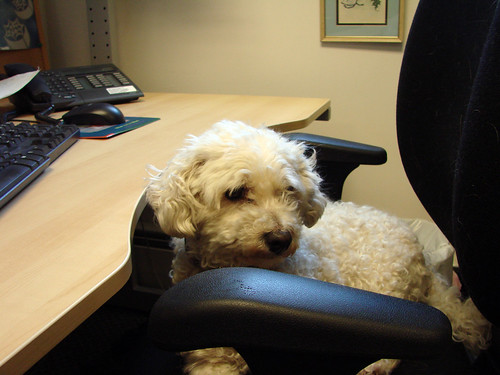
A few weeks ago, Photon had a seizure. It lasted about 45 seconds
and she was shaky the rest of the day, but by the next day she was pretty much
back to normal. She’d been growing more fragile in the past two years—I
couldn’t take her on road trips during my Conservation Big Year because there
were just too many long hikes and hot days for a 15-year old dog. While I was on trips, Russ and our son Tom took her for walks in the neighborhood, and she was still
all dancy and waggy when I’d come home. She was still eating with gusto and being
her happy self most of the time, but an ominous pall fell over our days. She had a tail-waggin’ happy birthday on April 4 when she
turned 16. But over the weekend she stopped eating, and Monday was very, very
weak. We called our veterinarian who said he’d come to the house at noon.
She
slept most of the morning, but about 11 o'clock, she unsteadily made her way to the back door.
I let her out and stood on the porch with her. A robin was singing away--the
very first robin song I've heard this year--and she sat down on the porch and turned her
face to listen to him. A chickadee sang in another direction, and she turned her face toward him, and then tracked a crow cawing as it flew over. Then she faced the robin again, listening intently for a lovely 10 minutes. When he stopped singing,
she slowly stood up and walked to the door. When we came in, I turned on a
recording I’d made of birds at dawn from one of our Wisconsin birding adventures. She made her way over to a comfortable spot and settled down, nestled against me sleeping until Dr. Hargrove came. It was time,
and her spirit rose ever so softly and gently, and slipped away.

